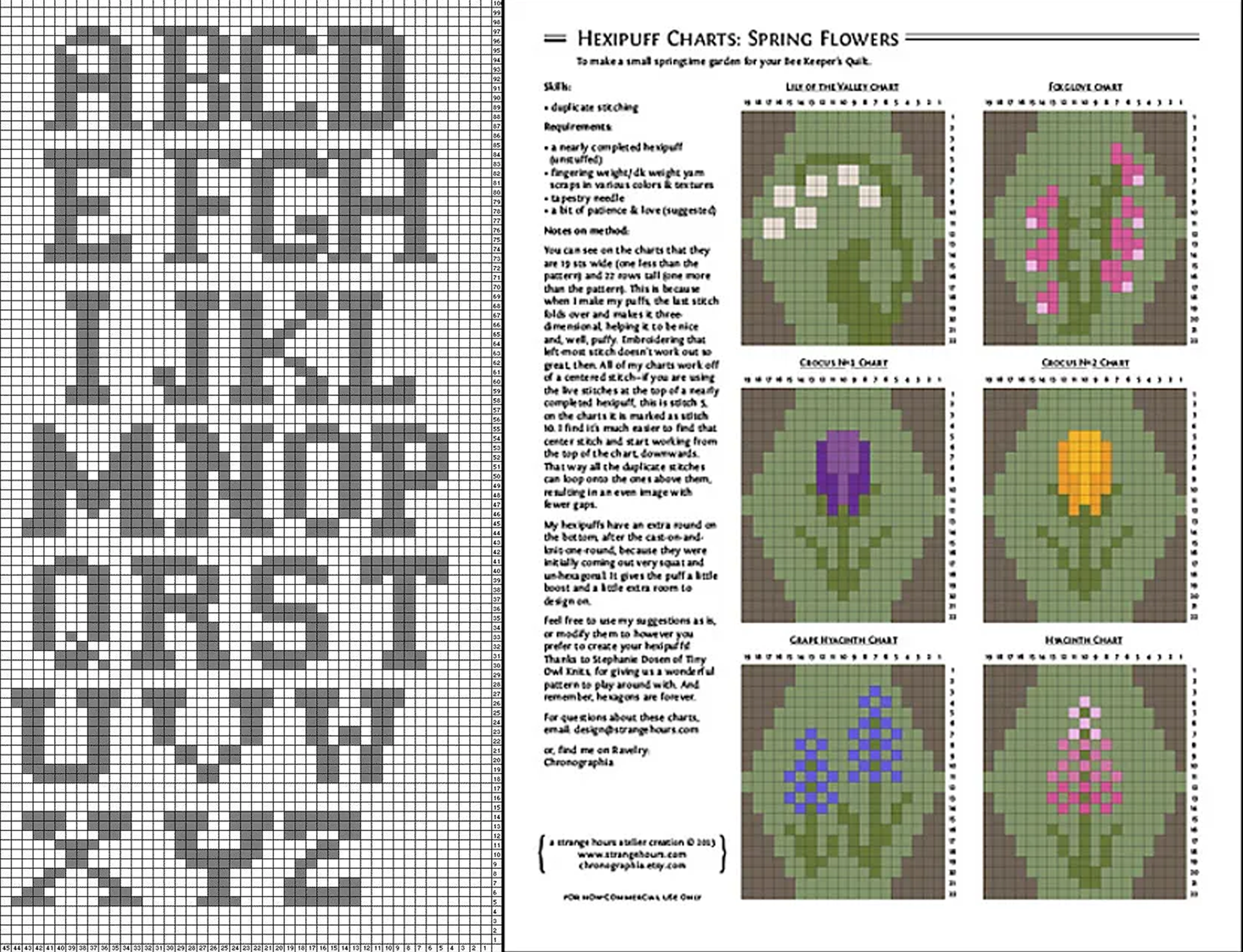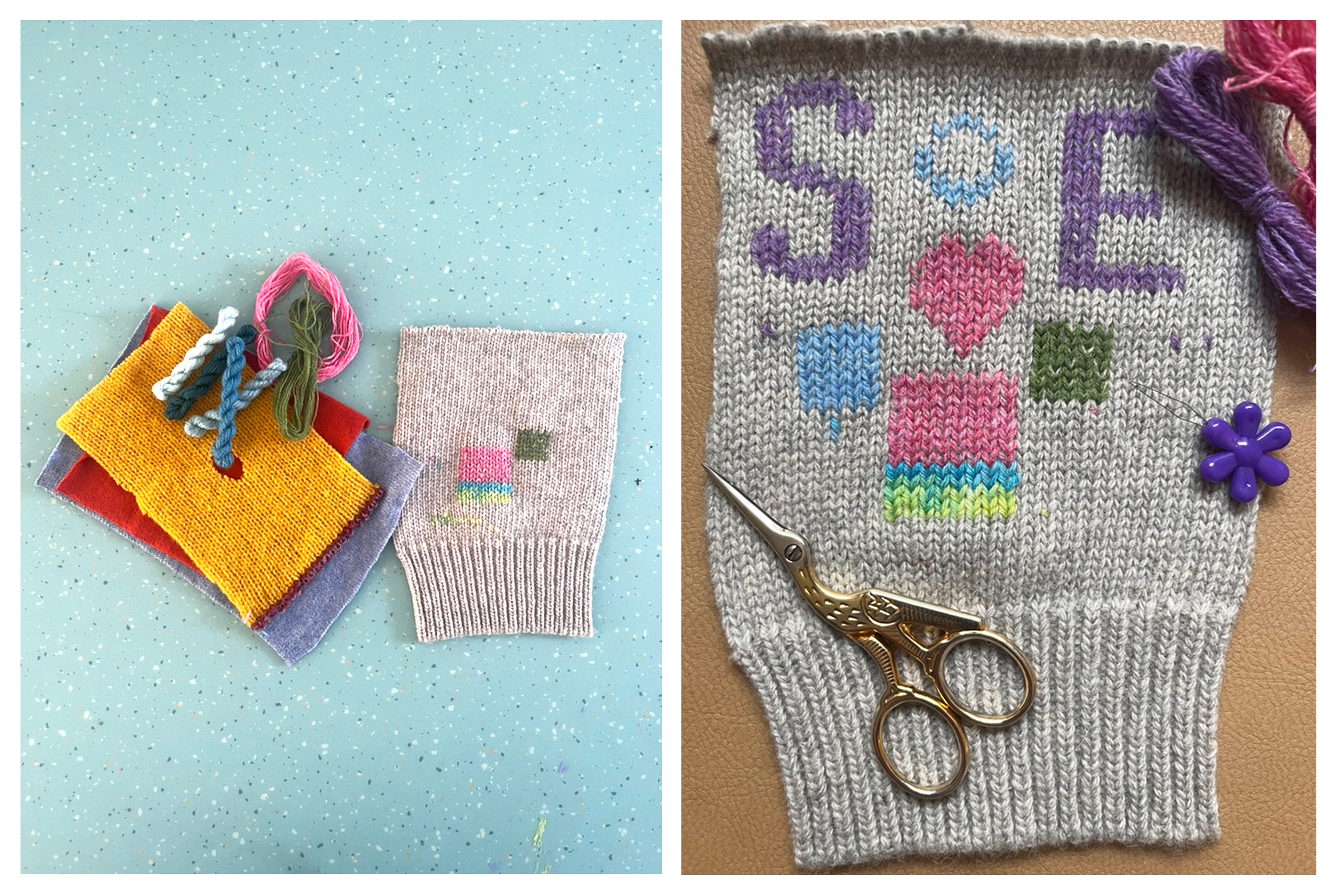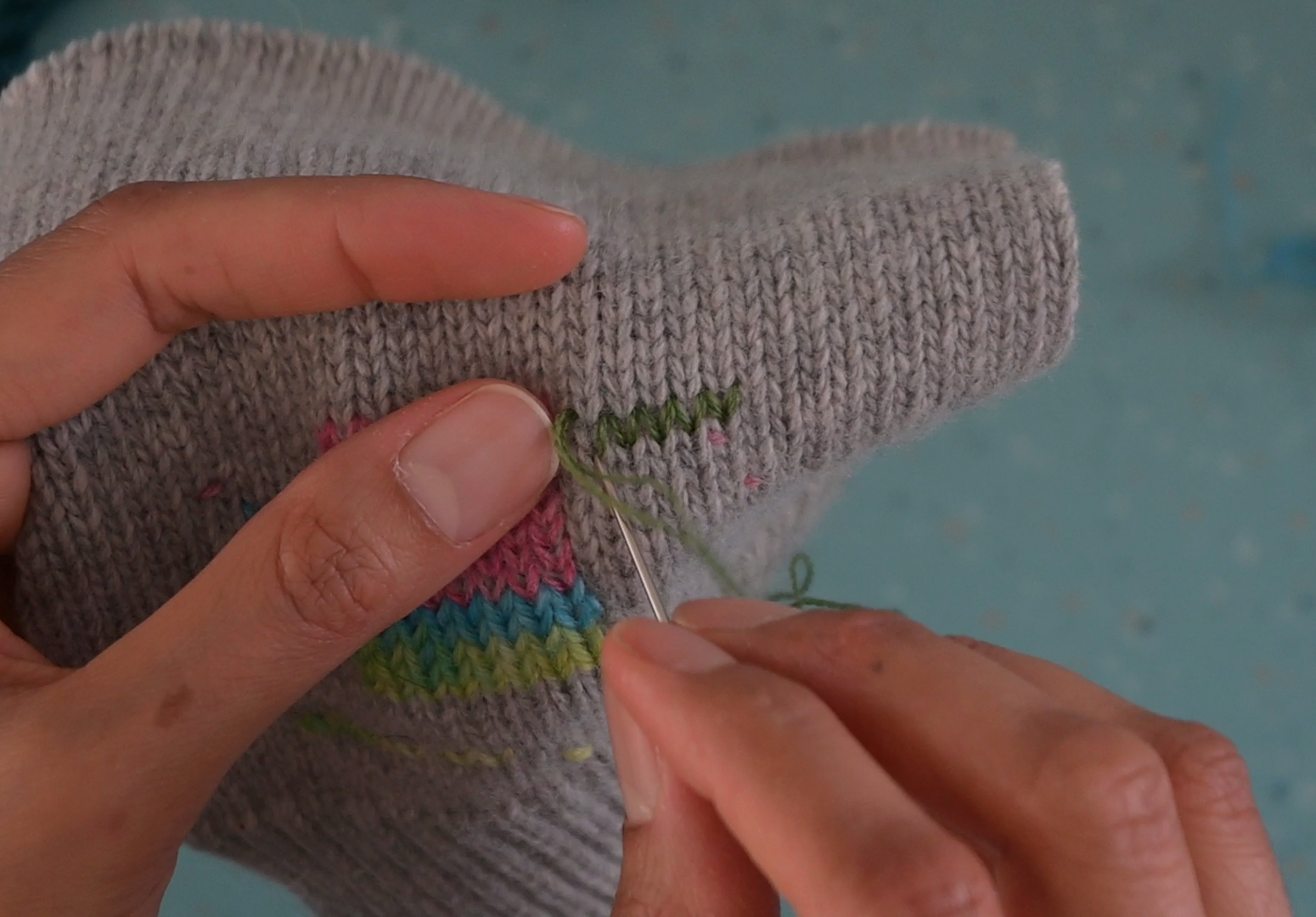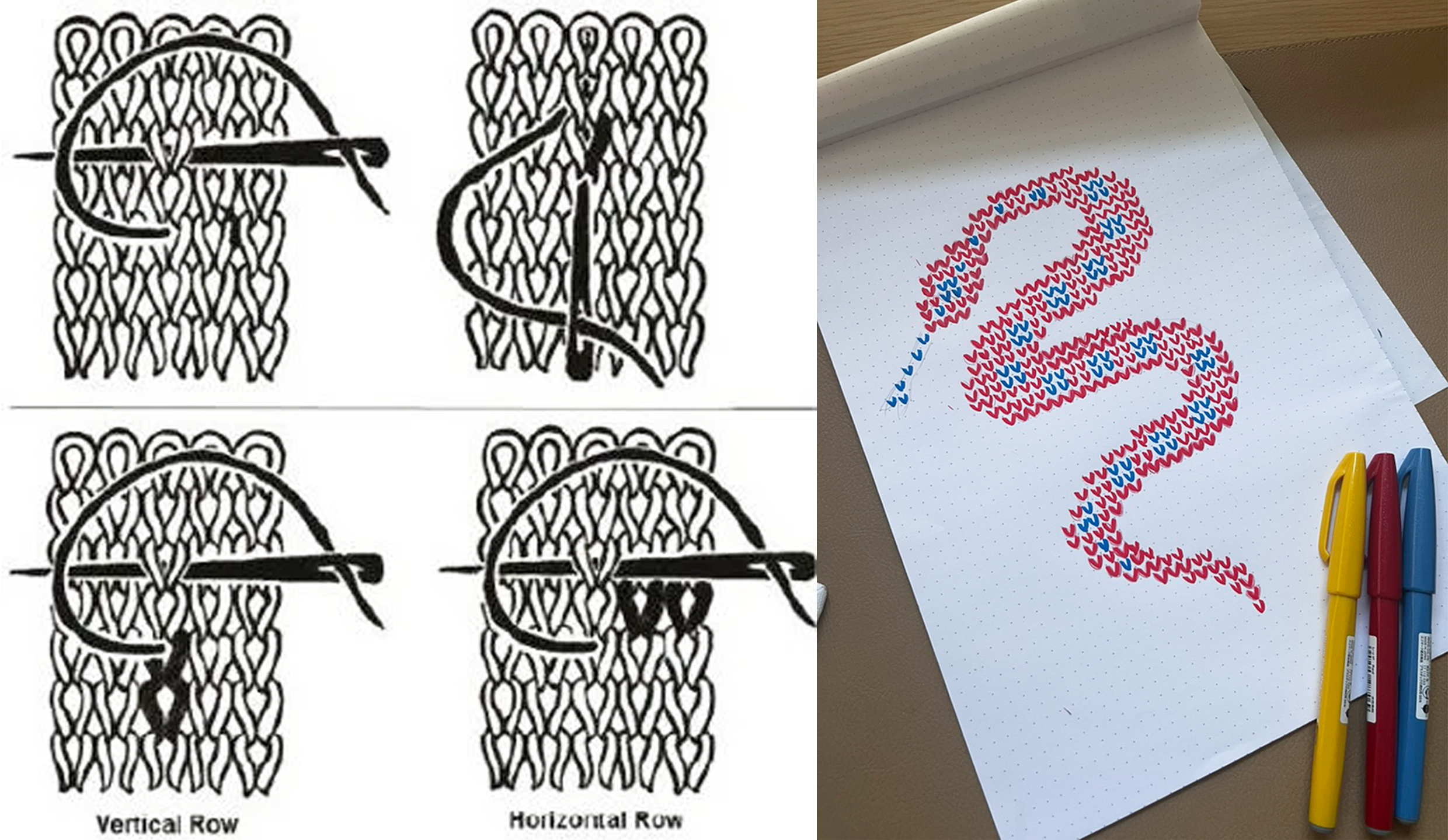Duplicate stitch
When attempting to learn the Swiss darning repair method, I realised that I had to learn the foundation of the stitch - the duplicate stitch. The Duplicate stitch is a decorative (embroidery) stitch that mimics the knit and purl (stockinette) stitch of knitwear. It is a great way to jazz up a piece of knitwear that you find a bit boring or lacking in the original charm it once had. It’s versatility also means it can be used to reinforce threadbare areas of your knitwear such as you may find on the elbows of your favourite jumper. I have to say – I love its versatility and the possibility of creating playful and cute designs on your knitwear.
However, I have to put myself in the shoes of a newbie – i.e. someone who is interested in learning this stitch but feels overwhelmed by the very prospect of engaging in what looks like extreme complexity causing them to completely shy away from it. I also think that most people learn about the duplicate stitch by first encountering the swiss darning repair method. That would definitely scare anyone – it does look incredibly hard. I know that when I first came across the duplicate stitch, it was because I wanted to learn the swiss darning method. I too was a bit afraid of attempting it. “How in the world?”, is all I could think when I opened countless textile and garment repair books and watched dozens ‘how to’ videos on YouTube. It was only when I attended a Toast repair workshop that I saw in person that the best way to learn the swiss darning repair method was to first learn its foundation stitch – the duplicate stitch.
Without a doubt, learning the duplicate stitch first will definitely help in overcoming the fear of darning that ever expanding or gaping hole in your favourite jumper. But aside from that, the duplicate stitch is an incredibly creative stitch. We often see quirky knitwear with fun patterns – these patterns are part of the knitwear design that is either knitted in by hand or machine when the garment is first knitted. What the duplicate stitch allows us to do is to mimic the purl and knit stitch with the potential of creating patterns if we wish to after the production stage of a piece of knitwear. This gives you the consumer, the potential to participate in the design of your knitwear as well the as the ability to exert your own creative agency. Yes that’s right – ‘Power to the people!’. This particular stitch can come across as twee or kitsch, but I feel veering toward more playful or surreal imagery combines these qualities quite well for the contemporary or ‘trendy’, ethical fashion enthusiast – Think Schiaparelli design features, circa forever. As we all know, if we are to engage more consumers in slowing down the rate of their consumption, then the methods and processes that designers use and consumers engage with needs to be captivating, enjoyable, creative, coveted and dare I say it – trendy - but in the popular social media movement - ‘made by me’ - way. If you know what I mean. In that sense, trendy becomes stylish – meaning that the consumer injects their own sense of self onto the garment.
Back to the duplicate stitch. As many (if not all) of my reflexive(+tive) journal articles are part of my ‘auto-ethnographic’ (I use this term loosely) exploration of how I as a practitioner understand the experiences of other practitioners and consumers as they engage in processes of making – in whatever form that may be - this journal article highlights the ‘trials and tribulations’ of learning a new stitch/design/making process. Including the complexities I experienced and the resources that were available to me. What reflexive(+tive) thinking and writing allows me to do is to take these understanding of experiences - whether mine or other practitioners and consumers - to project it into the future. That is - how can any of these subjective experiences be useful when designing products that inform human-product attachment or indeed, design strategies that may facilitate human-product attachment.
We already know by now, as mentioned above that I came across the duplicate stitch when trying to learn the swiss darning repair method. We also know that I could only really get my head around it when it was demonstrated to me live by a repair specialist at a Toast repair workshop I attended. That is why I decided that I would create a ‘process’ or ‘how to’ video after learning the stitch.
The learning process started on the journey home from the workshop – I had a few knitted swatches I had started whilst at the workshop and I had a couple of darning needles and some yarn. I also had one of my darning and repair source books which, now that I had seen the stitch demonstrated in person, seemed a lot clearer now. It did take a bit of time to get my head around the technique - but like all craft, art and design processes once you mastered the technique, you kind of get into the zone. The repetitive nature of sewing – pulling needle and thread through textile is soothing and meditative. Of course I made mistakes along the way but these were not hard to correct. I recognise that this may not be the case for people who do not have skills in sewing, stitching and knitting. I have run or taken part in plenty of workshops where participants become so flustered when they make a mistake, enough for them to abandon the whole project. This is a shame
This leads me to ask the question – how can I design ‘fool proof’ and easy to make co-created or co-designed products that facilitate Human-product attachment.
I know – gathered through my research – that one way for consumers to form attachment to their products, there needs to be enjoyment of the product that lasts over a year or more. I also know that one way to close the gap between producers/designers and consumers and to foster consumer enjoyment is through co-design and co-creation – How then can I eliminate the frustrations that a consumer may feel if they actively engage or participate in the design and making process.
My research is trying to tap into the sensory experience of embroidery making. Hand embroidery is an accessible craft however it does require a level of skill and craftmanship. We have to be honest, it is easy to see the difference between the stitching of a novice and the stitching of a professional with years of experience. But I think the question that we need to reflect on here is – what did it make the participant feel? Did it elicit some feeling of joy? I think that is what we are looking for. The stitching doesn’t really have to be perfect – it just needs to make the consumer feel good – i.e. tapping into their sense of self through the sensory experience of making.
So let’s go back – I felt more capable of attempting the duplicate stitch when a tutor had physically demonstrated the stitch to me. This explains the rise in making workshops. Perhaps as people, we love to gather together to learn. I am assuming. But we can’t all attend physical workshops all the time. However we live in the digital age – and we have to use that to our advantage. So after learning the stitch myself and experiencing the frustration, etcetera; I thought it would be a good idea to make a ‘process/how to video’ for people to learn the stitch, using clear imagery and footage and easy to understand instructions.
This will form part of data available on the open source creative digital hub that I am creating alongside my PhD research. It is called Circular Design Studio and you can find it here on Studio Erskine. It is a one stop shop for participants, consumers, sustainability enthusiasts to learn about circular materials, circular design methods, repair methods, product and material lifecycles and the sensory experience of these processes and materials. I also want this hub to be interactive – visitors can leave comments, ask questions, give feedback and tag us on social media showcasing their own creations. In essence, build a community design experience of fashion and textiles. I think that it is necessary to remove the mystic around making and production to generate co-knowledge and co-understanding of circular fashion and textile design processes between designers and consumers. Does having these resources easily available help consumers to engage more with their garments. Perhaps if I make the digital creative hub visually appealing, fun to be on and interactive – would that help?
Okay, okay – the first video (and ahem) my filming could improve, but this will get better with time. What I am trying to do, is engage with these processes as if I were an unskilled maker; to talk to skilled makers and to consumers to get a better understanding of these repair and design processes so that I can co-create/co-design products that consumers want to engage with over a long period of time and that evoke emotional durability for them.
To learn more about the Duplicate stitch visit here.
This article forms part of a series called the reflec(tive) + (xive) practice - a method I am using in the first study of my research called “Repair as a Sensory Experience”. It aims to establish a commentary on my findings as a maker, researcher and observer as I gather data from designers and repair specialists, consumers and my own design and making process. It acts as a means to understand the experiences of my research participants or my target audience by reflecting on my own experiences. Along with my research, it also provides insight on what strategies I can adopt to facilitate emotionally durable human-product attachment.
Reflexive writing - (of a method or theory in the social sciences) taking account of itself or of the effect of the personality or presence of the researcher on what is being investigated.
Reflective writing - Writing reflectively involves critically analysing an experience, recording how it has impacted you and what you plan to do with your new knowledge. It can help you to reflect on a deeper level as the act of getting something down on paper often helps people to think an experience through. Reflective writing is - Written in the first person; Analytical; Free flowing; Subjective; A tool to challenge assumptions; A time investment.



